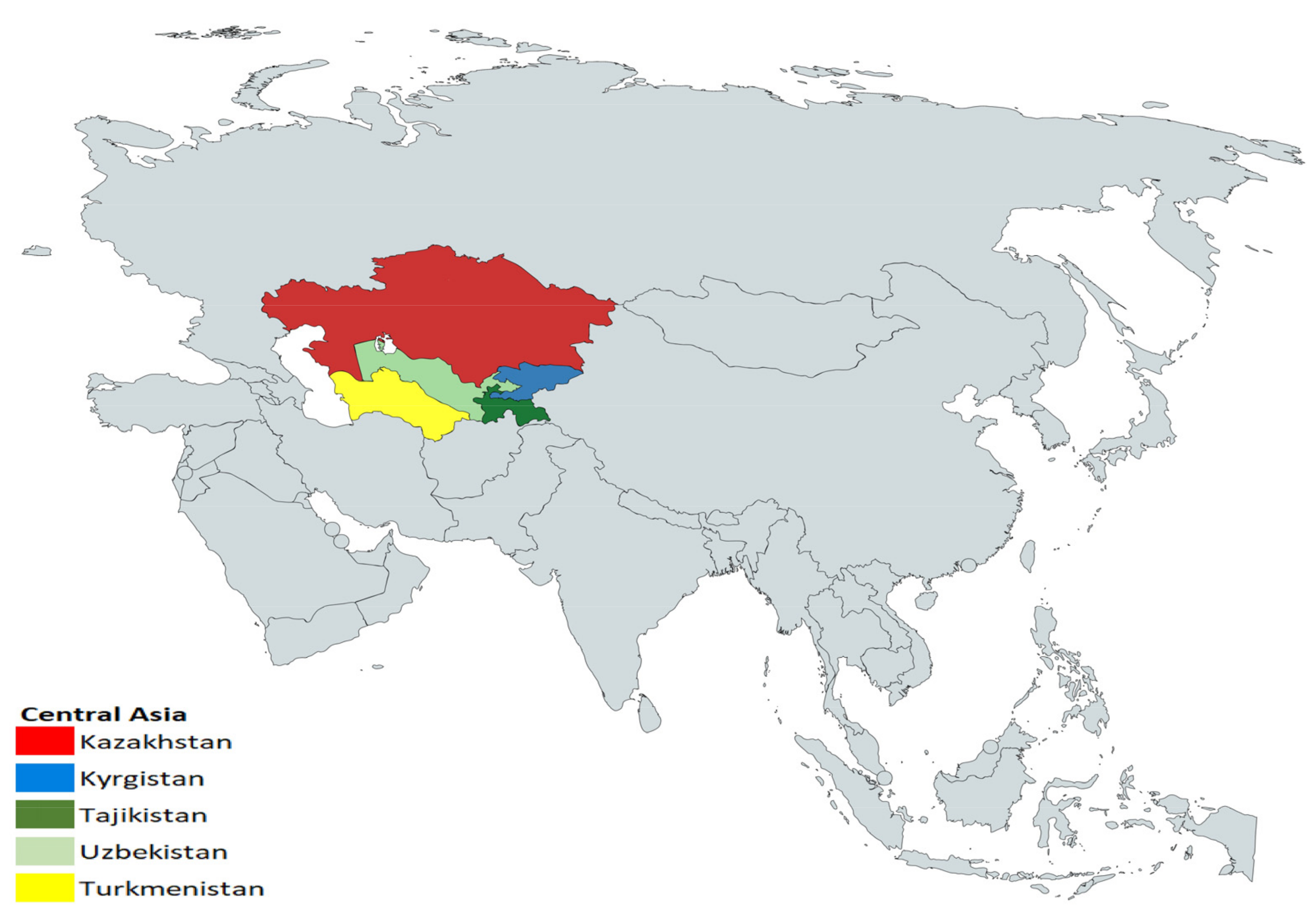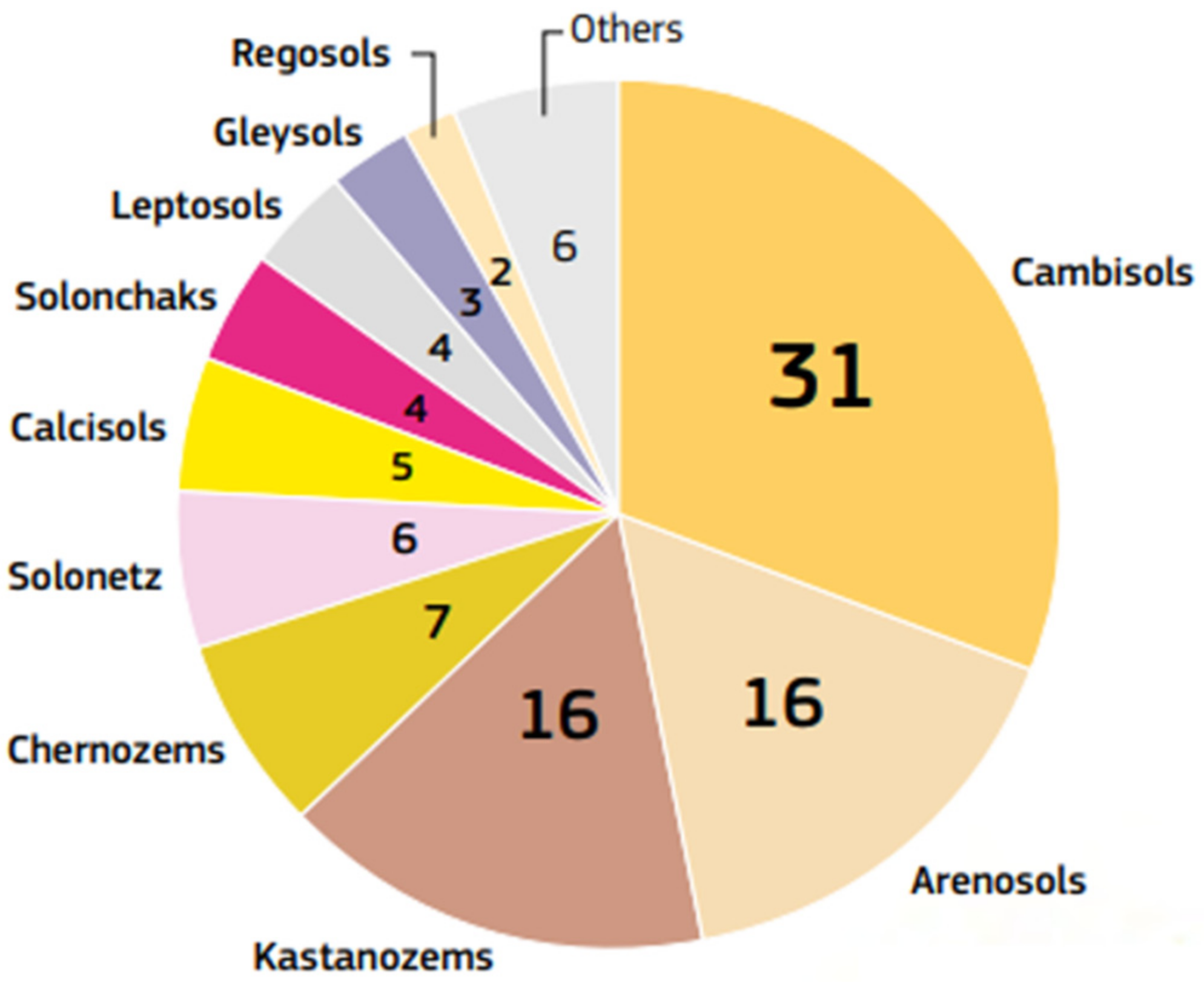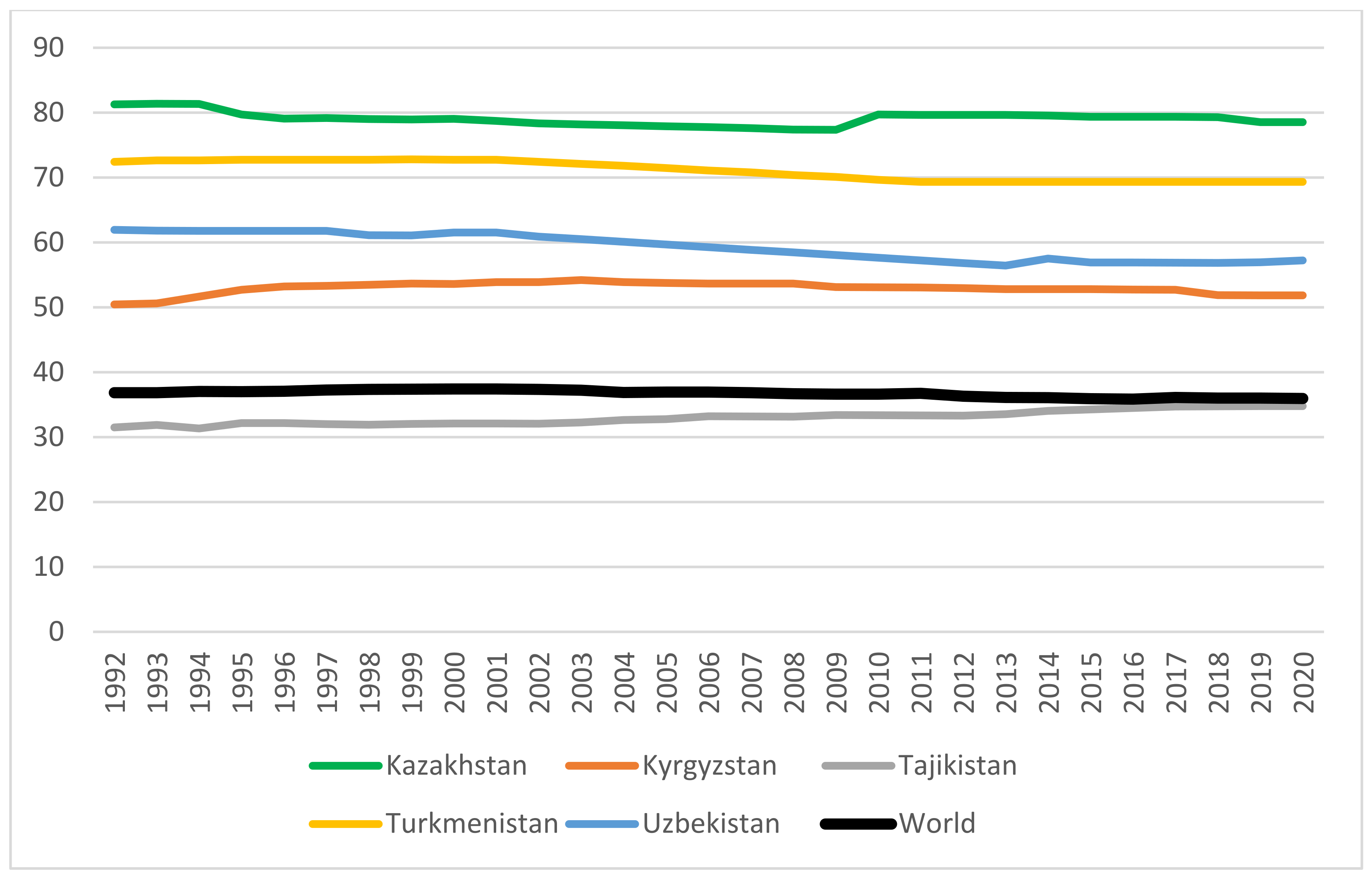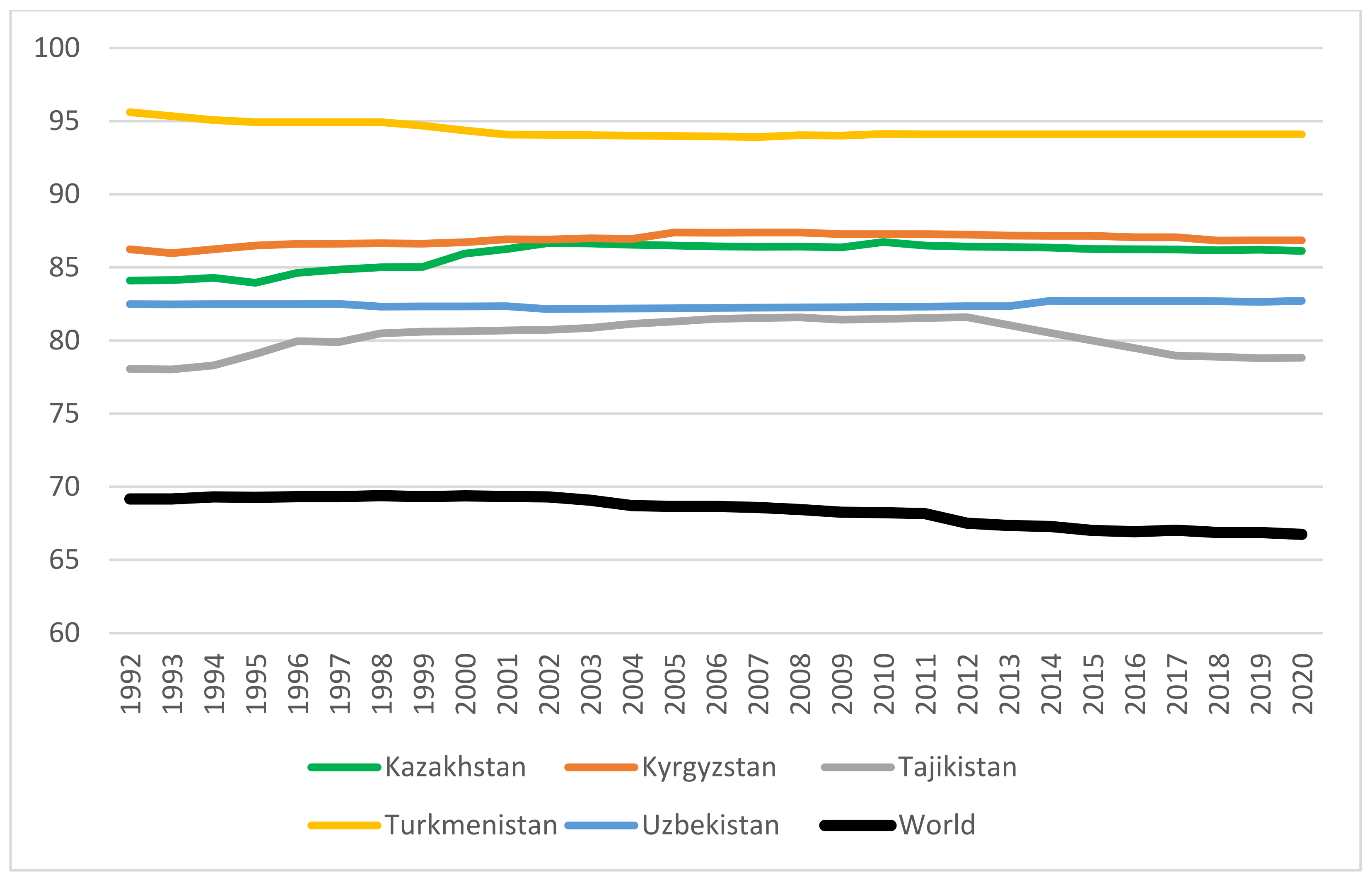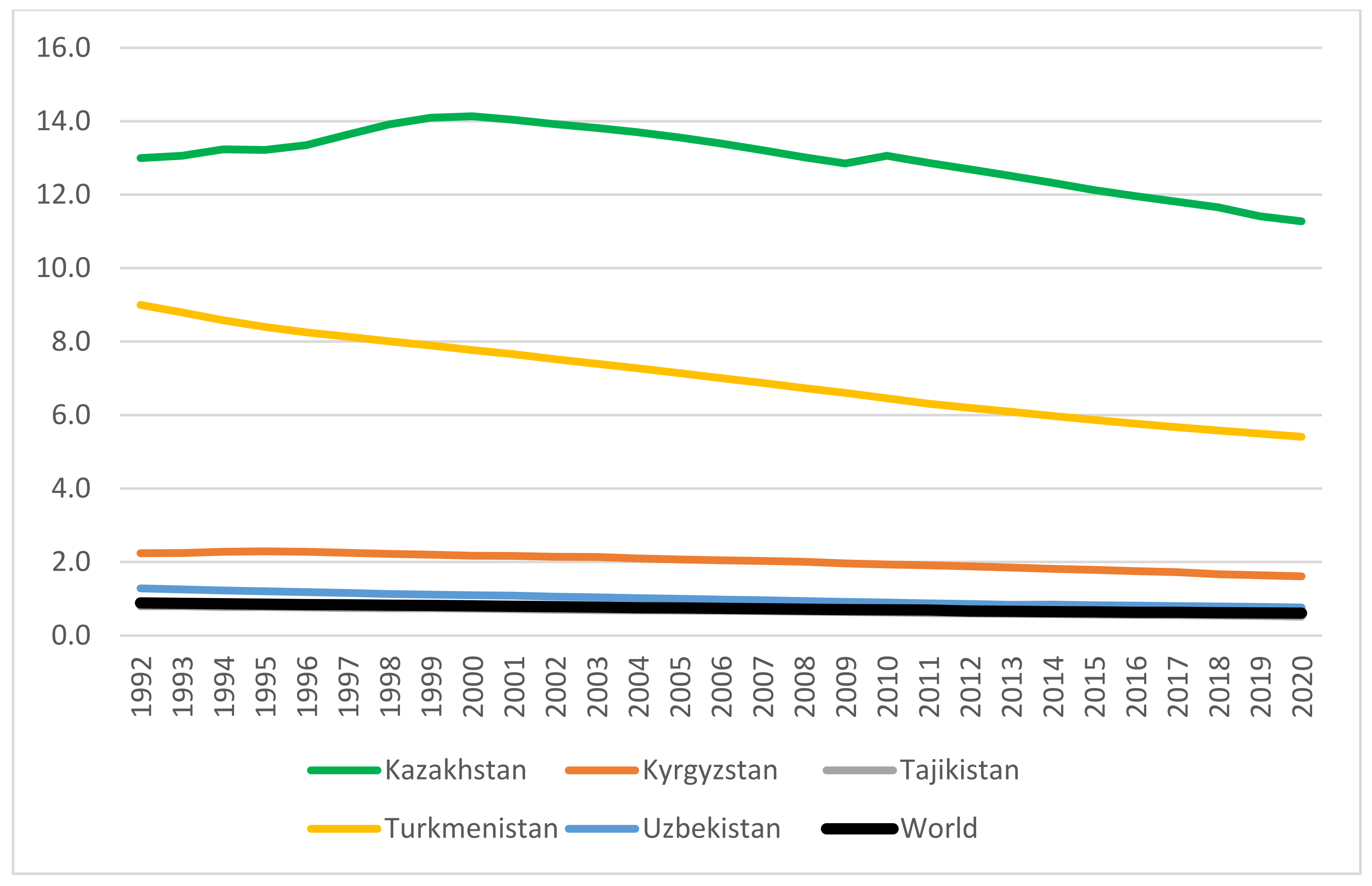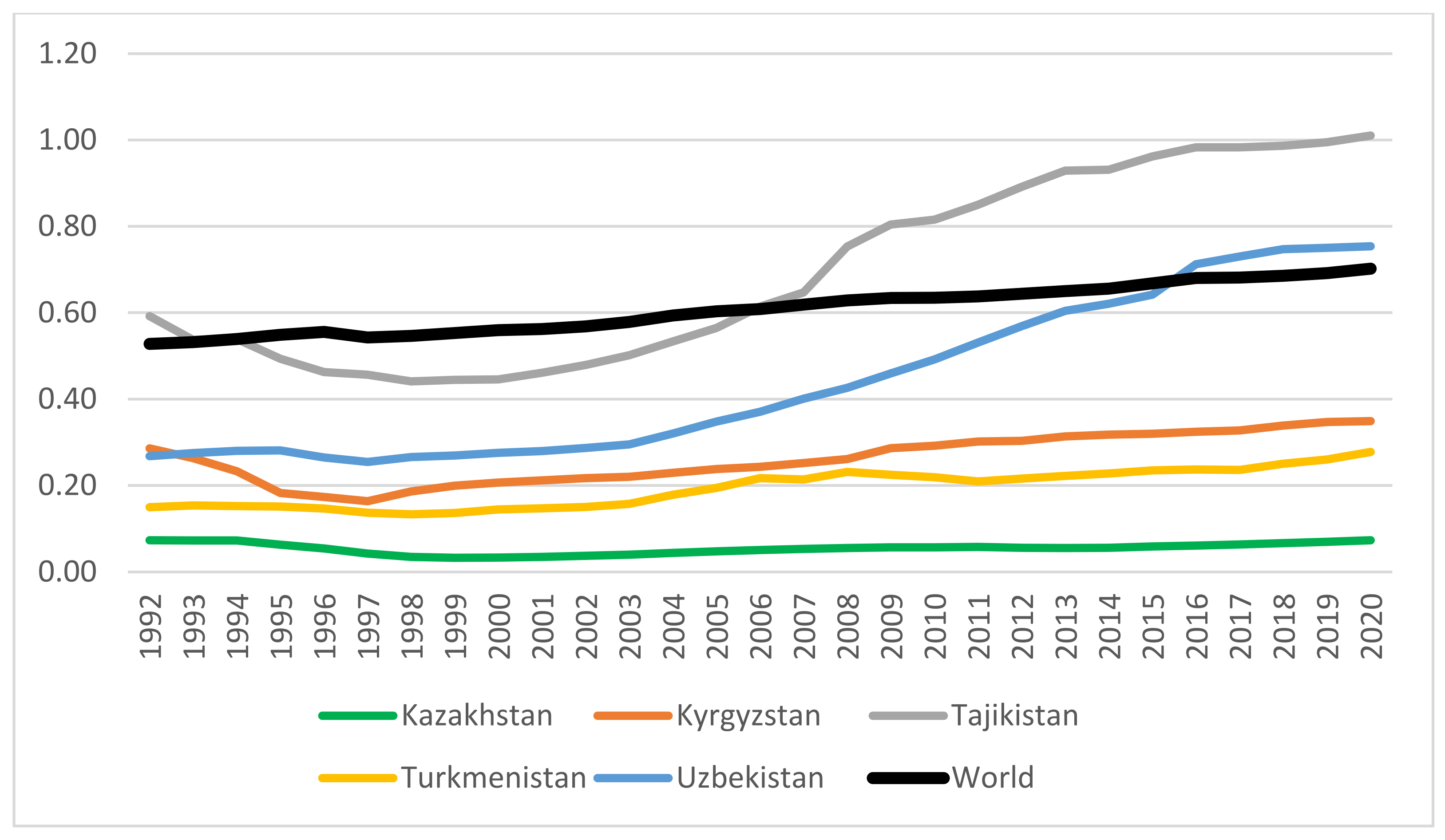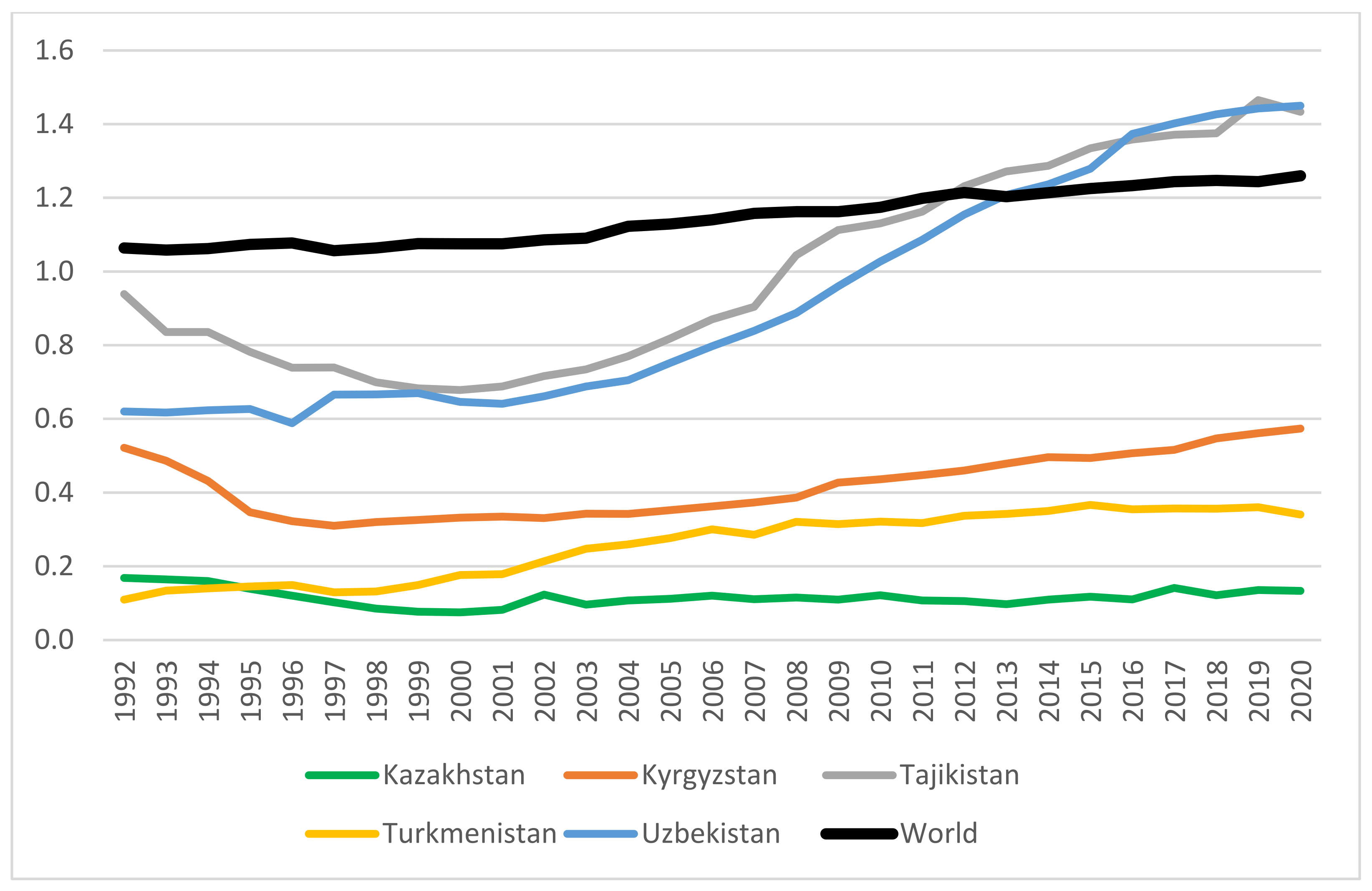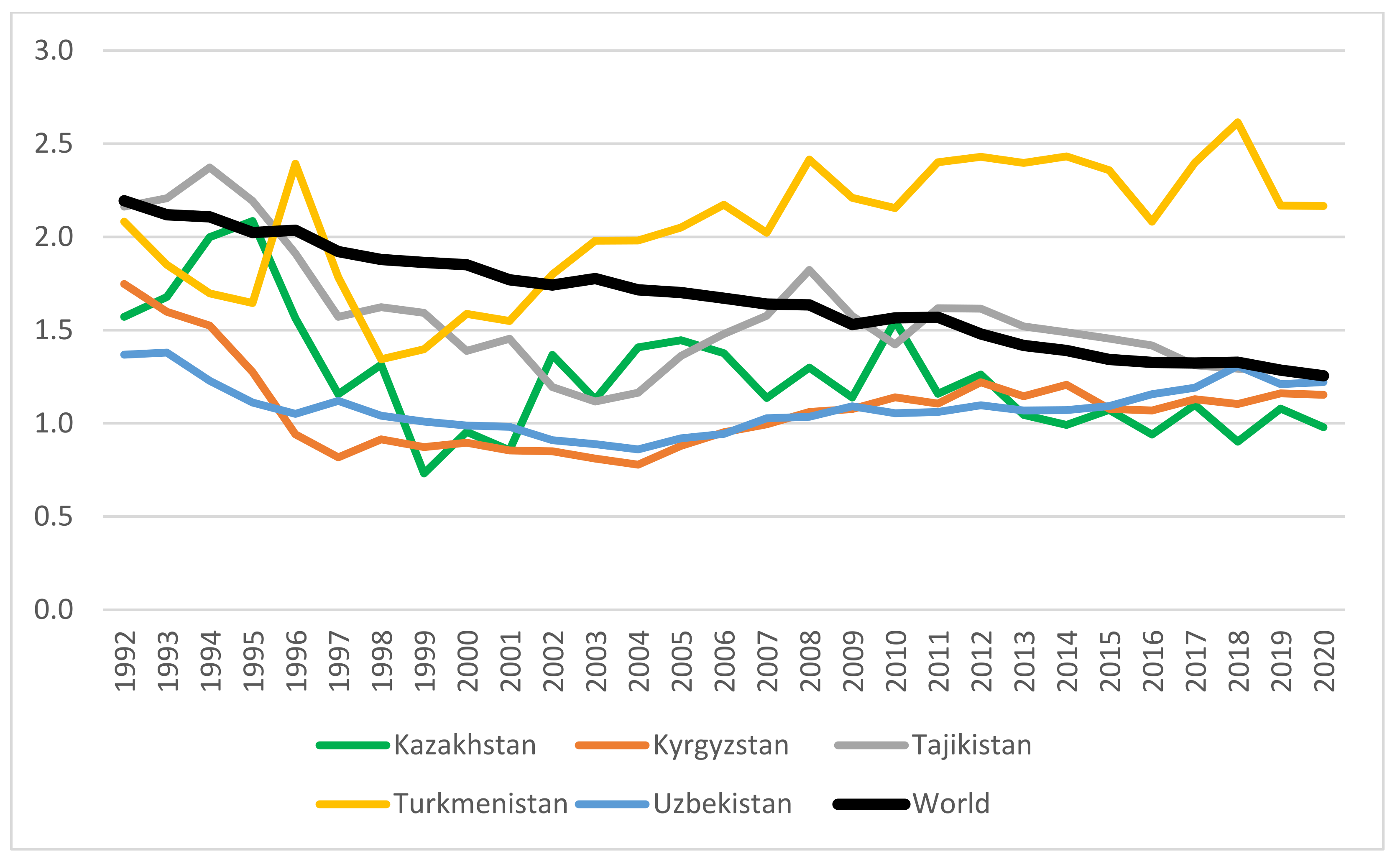1. Introduction
The current environmental condition of any part of the world is a combined effect of local environmental conditions and human activity. The former mostly includes soil quality and climate, especially the availability of sufficient water resources in the growing period. They determine both the intensity and possible types of vegetable and animal production [
1]. In turn, human activity mostly consists of a skillful adjustment of local natural conditions in accordance with crop requirements (and, indirectly, with what is required for animal husbandry). Hence, it enables the production of much more food than what is offered by nature itself, but all within the limits imposed by the aforesaid natural factors. In this context, note that agriculture plays a key role in the economy and in society by providing food to address the essential non-postponable consumption needs. The fact that this sector has a small contribution to GDP in most countries around the world is without prejudice to its importance. The last decades have witnessed progress in agricultural production (mostly including mechanization, and an increased use of chemicals and genetics), which allowed for considerably reducing (yet not eliminating) hunger, but posed another problem, i.e., the environmental impacts of agriculture, including its contribution to greenhouse gas emissions. This is all the more complex since agricultural production, which is essential for society, depends on climate while also affecting the way it changes. Under the assumption that the possible production lines are aligned with local climate conditions, it needs to be additionally assumed that the changes in annual weather patterns have a detrimental rather than beneficial effect on production conditions.
Therefore, a conflict arises between two important aspects, namely agricultural production and its environmental impacts (including on global and local climate). It is reasonable to expect that solving this problem will require engaging both the market mechanism (which drives the creation of innovative, resource-efficient solutions) and the government, which, through its policies, provides a legal framework for areas where market solutions fail (i.e., mostly in cases where implementing them is economically unviable for producers and consumers). Nevertheless, it is worth taking a look at the evolution of relationships between the volume and environmental cost of agricultural production over the last decades, taking account of the natural and social (anthropogenic) reasons behind it.
It is all more important to use Central Asian countries as a case study since they demonstrate specific conditions in both natural and social terms. Until the early 1990s, all of them (Kazakhstan, Kyrgyzstan, Tajikistan, Turkmenistan, and Uzbekistan) were Soviet republics, and were therefore subject to the agricultural policy of the USSR, which consisted, to put it short, of the domination of large cooperative farms (kolkhoz) and state-owned (sovkhoz) agricultural holdings.
In regards to natural and geographic conditions, they are located in the Eurasian interior, far away from large bodies of water (especially oceans), which is the reason why agricultural land is mostly used for meadows and pastures. These uses are less productive than arable land, which, in turn, has an impact on the capacity to provide enough food and—as a consequence—on the population density.
It is also reasonable to assume that more extensive production patterns result in smaller emissions of agricultural greenhouse gasses. However, in this context, it is important to examine the environmental and climate cost intensity, which is defined in this paper as the ratio between the amount of agricultural energy produced and that of related greenhouse gas emissions.
The purpose of this paper is to check whether there is growth or decline in the environmental and climate cost intensity of Central Asian agriculture in the context of natural and anthropogenic conditions.
2. Natural and Social Characteristics of Central Asian Agriculture
This study focuses on inland Central Asian (
Figure 1) territories facing diverse natural conditions and having a variety of land relief features (European Commission, 2023), which are not always favorable to farming activities. The region is subject to a continental climate with hot, dry summers and long cold winters.
However, as it accounts for ca. 9% of total Asian landmass, it offers a wide variety of farming conditions. When it comes to total rainfall, the western part of Central Asia is particularly dry, whereas the mountainous areas and the eastern part of the region receive slightly more precipitation [
2]. Additionally, the consequences of climate change exacerbate the problem of extreme weather conditions and thus have a negative effect on agricultural production [
3,
4]. Examples include the severe drought witnessed in the region in 2021 [
5] or soil erosion, which especially affected the northern part of Kazakhstan [
6]. Hence, in view of the climate crisis, it will be necessary to use knowledge and technology in order to maintain food security at a satisfactory level [
7].
The region’s land relief is dominated by steppe and desert plains, whereas high mountain ranges are the landscape’s remarkable features. Despite a high share of desert areas in Central Asia, the prevalent soil type (ca. 30%) is a highly fertile cambisol (mostly found in Kazakhstan). Arenosols, sandy-textured soils with a small water-holding capacity and low nutrient content, account for ca. 16% of the region’s landmass, and are the prevailing soil type in Turkmenistan (
Figure 2). Kastanozem also holds a 16% share, is characteristic of steppes, demonstrates relatively favorable agricultural properties, and can be mostly found in the northern part of Central Asia. Chernozem, a soil type with a high humus content, is suitable for agricultural uses and covers 7% of the region [
2]. As the territory covered by the study is extremely large, it demonstrates high levels of biodiversity, including the presence of endemic plant and animal species. Another aspect of importance is the existence of numerous water courses and lakes [
8]. The most important Central Asian rivers include Amu Darya, Syr Darya, Irtysh, Hari (Tejen), and Ural. Balkhash, the fifteenth largest lake in the world, is an important body of water located in southeast Kazakhstan [
2].
To sum up, Central Asia demonstrates a wide variety of agricultural production conditions. Importantly, it is dominated by fertile soils, which are crucial for the efficiency of farming activities. A key role is also played by abundant water courses and the Balkhash Lake. However, the region is also affected by unfavorable conditions, such as high mountain ranges, steppes, and intense desertification areas, which are poorly suitable for agricultural production uses. What also needs to be emphasized is that weather conditions include a broad annual temperature range, which affects the particularities of agricultural production in the region. As noted by Su et al. [
9], despite the negative effects of climate change, the region witnessed an increase in food security, with the highest levels being recorded in Kazakhstan (due to it having optimum conditions for agricultural production). In turn, Tajikistan is the least food secure country, which is also due to unfavorable conditions.
3. Economic Transformation After 1991
Central Asia consists of five culturally and ethnically different countries which have followed different paths of political and economic transformation during the last 25 years after gaining independence from the Soviet Union [
10,
11]. Kazakhstan and Kyrgyzstan progressed relatively well in implementing their market reforms, whereas Turkmenistan and Uzbekistan still have not completed their transformation towards a market economy. Tajikistan is at an intermediate stage [
12]. Each country adopted a different strategy of economic transformation [
13]. However, the general economic turmoil initially only contributed to economic downturns [
14]. Therefore, changing the policies in place in Central Asian countries required a diversified approach. Moreover, the dissolution of the Council for Mutual Economic Assistance highlighted the region’s disparities and economic problems.
As a consequence, the Asian economy experienced a wide variety of complex transformations after the collapse of the USSR [
15]. The region has become one of the key players in the global economy, with a clear distinction between developed economies (such as Japan or South Korea) and dynamically growing ones (such as China or India). Economic growth, urbanization, technological innovation, and globalization affected the development of economies, which attracted global interest [
16]. However, the countries and regions continue to differ significantly from one another.
The dissolution of the USSR in 1991 had a considerable impact on the development of Asian agriculture, especially in former Soviet republics [
17,
18]. The agrarian reforms in countries such as Uzbekistan and Kazakhstan resulted in land being distributed between private owners [
19]. Uzbekistan introduced a system referred to as “dehkan” which enables self-employment in farming and, therefore, contributes to growth in agricultural production [
20,
21]. However, despite the reforms, many countries initially struggled with problems, including the neglected infrastructure, which had a considerable impact on agricultural productivity. Another issue was that of insufficient technological resources. Also, the lack of capital significantly hampered investment, and the shift to a market economy made prices unstable and resulted in market outlets being inaccessible.
However, as time went by, Central Asian countries started to develop different agricultural sectors, such as marketable crops. Examples include Uzbekistan, which became one of the world’s biggest cotton producers [
22]. In turn, Kazakhstan increased meat and milk production which contributed to its self-sufficiency in food [
23]. Over the recent years, increased attention has been paid to sustainable agricultural development, and has resulted in the introduction of environmentally friendly state-of-the-art cropping techniques [
24,
25].
Central Asian countries became committed to integration with international markets, which helped attract foreign investments and technology [
26]. Collaborations with international organizations and neighboring countries have become key for agricultural development. The countries continue to struggle with multiple challenges, such as climate change which affects yields, and the need for further modernization of the agricultural sector. In the future, a key role will be played by the introduction of technological innovation and the development of sustainable farming practices. The development of Asian agriculture following the dissolution of the USSR has been complex and a process full of both challenges and opportunities. As such, it keeps evolving to this day.
4. Materials and Methods
The study covered Central Asian countries, namely Kazakhstan, Kyrgyzstan, Tajikistan, Turkmenistan, and Uzbekistan. The results were compared to worldwide figures (147 countries with a population of more than 1 million, subject to data availability). The study relied on FAOSTAT data for the years 1992–2020, i.e., the period where the countries became independent and for which statistical data are available.
The successive analyses relied on a series of variables relating to natural conditions of agricultural production, social aspects of farming, agricultural productivity, and agricultural impacts on the environment and climate. The following data were retrieved from the FAOSTAT database to meet that goal:
area of the country in ha,
agricultural land in ha,
arable land in ha,
permanent pasture in ha,
total population (both genders),
food supply in kcal per capita per day (all product aggregates),
domestic supply in tons (all product aggregates),
output in tons (all product aggregates),
emissions (IPCC Agriculture) in tons of CO2eq,
animal numbers for all species covered by the FAOSTAT database.
An important part of this research consists of assessing the environmental cost intensity of agricultural production, defined as the relationship between inputs and outputs; inputs are the quantity of greenhouse gas emissions whereas outputs mean the amount of energy produced by agriculture.
The first abovementioned metric, which determines the climate and environmental costs of agricultural production, was retrieved directly from the FAOSTAT database.
The production volume was presented as the number of kilocalories produced by agriculture. The reason for adopting this approach is the fact that energy is measured in an objective way, and its actual value is invariant over time, unlike financial figures. Thus, it is possible to convert the entire agricultural (crop and livestock) production to a single universal unit [
27,
28,
29,
30]. The authors used their own method in estimating it:
Ew: amount of energy derived from agricultural production (kcal per year),
Esi: food supply of agricultural product i (kcal per capita per year),
P: Population,
Wi: food self-sufficiency ratio for product i
where
Pi: output of product i (tons per year),
Zi: domestic supply of product i (tons per year).
The amount of energy produced by agriculture was estimated using selected items of the quantitative food balance sheet calculated for each product as per the FAO methodology (variables used in determining the food self-sufficiency ratio are marked in bold):
domestic supply quantity =
output +
imports +
stock variation –
exports
The results were presented in a graphical form, as linear graphs spanning over a nearly 30-year period.
Based on the data used, the following measures were determined for each year:
for natural determinants of agricultural productivity
- ○
share of agricultural land in countries’ area
- ○
share of permanent pasture livestock units per hectare of utilized agricultural area in utilized agricultural area
for social aspects of agriculture
- ○
hectares of utilized agricultural area per capita
- ○
population density in persons per square kilometer
- ○
consumption in kcal per capita per day
for agricultural production
- ○
agricultural production in thousands of kcal per hectare of utilized agricultural area
- ○
stock density in livestock units per hectare of utilized agricultural area
for greenhouse gas emissions and environmental cost intensity of agriculture
- ○
agricultural emissions in t CO2 per ha of agricultural land
- ○
agricultural emissions in t CO2 per capita
- ○
environmental cost intensity of agricultural energy production in kg CO2 per 1000 kcal produced.
5. Results and Discussion
5.1. Natural Determinants of Agricultural Productivity of Central Asian Countries Against a Worldwide Background
Agriculture, like any other business, is focused on addressing the more or less complex needs of individuals and whole communities. However, the particularity of this sector is that its production capacity is largely determined by natural conditions and by the fact that it must address fundamental, non-postponable food needs. Both the needs and production capacities strongly determine the environmental impacts of agriculture, including the amount of greenhouse gas emissions. Due to such a combination of mutual relationships, attention must first be paid to the natural conditions which determine the ways and possible intensity of land use while also having an impact on the amount of agricultural greenhouse gasses and environmental efficiency. For obvious reasons, these same natural factors affect a number of social aspects while, however, not being their final determinant (as will be analyzed later in this study).
Central Asian countries are a good example of these phenomena and their mutual complexity. This is because their common characteristic is that they are located in the Eurasian interior, far away from large bodies of water. As mentioned earlier in this paper, this results in small rainfall, which, in turn, affects land productivity and the way land is used. Nevertheless, the share of agricultural land differs considerably between the countries, from ca. 30% in Tajikistan to over 80% in Kazakhstan (
Table 1,
Figure 3). This is the combined effect of multiple factors, including land relief (Tajikistan and Kyrgyzstan are largely mountainous) and the presence of deserts. However, what makes this group of countries particular is that the share of utilized agricultural area is similar to the worldwide average level only in Tajikistan, and is much higher in other countries. Nevertheless, permanent pasture has a prevailing share in the mix of agricultural land uses in all countries covered by this study (
Table 1,
Figure 4). While this is the dominant way of using agricultural land around the globe (accounting for ca. 70% of utilized agricultural area), in Central Asia, it varies in the range of ca. 80% in Tajikistan to ca. 95% in Turkmenistan. This is an obvious consequence of these countries being located in the Eurasian interior, as mentioned above. In this context, note that agricultural land uses have not essentially changed over the years. This is indirect proof of what was said before, namely that human economic activity has the capacity to improve the natural productivity of land, though within the limits imposed by nature (primarily including geographic factors).
5.2. Social Aspects of Central Asian Agriculture
Natural agricultural production inputs determine certain aspects of how societies live. This paper focuses on three variables relating to land uses (
Table 1,
Figure 5 and
Figure 6) and to the ultimate consequence of agricultural production, i.e., the consumption volume (
Table 1,
Figure 7).
The agricultural sector’s production capacity has a significant impact on the size of the population which may live on the territory concerned. This translates into the area of agricultural land per capita at the country level. In Central Asia, it varies strongly from one country to another, with the highest levels being recorded in Kazakhstan (over 10 ha throughout the study period, and 14 ha in the early 2000s) (
Table 1,
Figure 5). The figures reported in Turkmenistan are slightly smaller, yet still considerably above the worldwide average. While both countries demonstrate a high share of agricultural land, it is dominated by permanent pasture, which is less productive than arable land (the latter having a prevailing share in Europe and Southeast Asia) [
27]. Therefore, there is a need for a much larger area to provide enough food per capita. Note also that even in Kyrgyzstan, the abovementioned ratio is nearly twice as high as the worldwide average level. Uzbekistan and Tajikistan are the sole exceptions among Central Asian countries. While the differences in the area of agricultural land per capita between geographic areas are determined by natural conditions, changes in that ratio depend on demographic pressures, on the one hand, and on agricultural progress, which enables growth in land productivity, on the other. It is reasonable to assume that in the late 1990s/early 2000s, it was essentially impossible to increase the area of agricultural land, especially in countries where it already occupied nearly the whole national territory or in those largely covered by mountains or deserts. Over the three decades covered by this study, Central Asia witnessed moderate demographic pressures, and therefore, the decline in agricultural land per capita was relatively small. The greatest drop (over the whole study period) was recorded in Kazakhstan and Turkmenistan.
If the problem is approached from the perspective of the agricultural sector’s capacity to provide enough food, population density (
Table 1,
Figure 5) depends on the share of agricultural land and land productivity. Hence, in a way, it is the inverse of the agricultural-land-per capita ratio. Due to the reasons referred to above, Central Asian countries differ from one another in population density. However, only Tajikistan and Turkmenistan are above the worldwide average level. Interestingly, the greatest growth was witnessed in countries where it was high already at the beginning of the study period. Population density is much below the global average in Kazakhstan and Turkmenistan, i.e., in countries which have a large share of agricultural land with a prevailing role of permanent pasture.
As mentioned earlier, natural conditions affect (but do not fully determine) a series of social aspects of how a country operates. This is especially true for the quality of life. Bearing in mind the complexity and vagueness of that term, it can be looked at from the perspective of the agricultural sector’s fundamental function which is to provide life energy for human bodies and, thus, for entire communities. Note once again that this is a function of key importance which affects the whole complexity of social life. Most other parameters of Central Asian countries usually differed considerably from global average levels and remained quite stable over the three decades covered by the study. It was on the contrary for consumption (
Table 1,
Figure 7), which grew quite rapidly and seemed close to global average figures, especially in recent years of the analysis. Throughout the study period, only Tajikistan recorded consumption levels below the worldwide average (but still managed to obtain very close to it in the last years). It was the opposite in Kazakhstan, which recorded the highest level of consumption of all Central Asian countries in 2020. Equally interesting is the fact that most countries witnessed growth in the average amount of calories consumed for most of the study period, except for Tajikistan and Uzbekistan in the early 2000s. However, the latter saw considerable progress, and as a consequence, its consumption level recorded in 2020 is much above the global average and only slightly smaller than in Kazakhstan. The above means that while natural conditions have an impact on the population size which can be provided with food in a certain location, they do not translate into actual social effects reflected by such an important variable as the consumption volume The latter is the outcome of human activity, as mentioned earlier, which has the capacity to improve the natural fertility of soil within the limits of natural factors.
5.3. Agricultural Production
For reasons referred to in the methodology section, the amount of agricultural production is expressed in kilocalories per hectare of utilized agricultural area. While the regional differences in that ratio depend on natural conditions (mostly climate and soil), its growth rates are the effect of informed action taken by humans. This includes the activity of farmers themselves but also of scientific centers and enterprises dealing with agricultural matters which create innovative solutions designed to improve land productivity. Obviously, measures focused directly on production growth are reasonable only in two cases. The first is the inability to supply enough food products for the population, and the second is demographic pressure. Therefore, the greatest production growth was witnessed in Tajikistan and Uzbekistan (
Table 1,
Figure 8) which—in a Central Asian perspective—had a relatively small area of agricultural land per capita (
Figure 5), and were far below the global average consumption level (
Table 1,
Figure 7) in the late 1990s/early 2000s (the latter statement being especially true for Tajikistan). Conversely, countries which did not experience demographic pressure and maintained consumption at a satisfactory level throughout the study period did not need to improve land productivity (this is especially true for Turkmenistan and Kazakhstan).
The volume of agricultural production depends on multiple factors, including animal numbers. In turn, the level of and growth in animal numbers depends on the ability to produce an adequate amount of feed from plants, and on-demand pressures. The latter essentially results either from population growth or from society becoming wealthier (which usually involves a greater consumption of animal products). This is especially important in Central Asian countries where meadows and pastures are the prevailing use of arable land, somehow forcing the local farmers to engage in animal production. In this context, note that the greatest growth (
Table 1,
Figure 9) was recorded in Tajikistan and Uzbekistan, i.e., countries which were much below the global consumption levels in the early 2000s (
Table 1,
Figure 7). This triggered the need for production growth (which took place, see
Figure 8), affected to a certain degree by an increase in animal density. Things look different in Kazakhstan, which kept food supply at quite a high level throughout the study period while also having an extremely large area of agricultural land per capita (
Table 1,
Figure 5).
5.4. Greenhouse Gas Emissions and Environmental Cost Intensity of Agriculture
As agriculture is a production sector, different environmentally harmful emissions (including greenhouse gasses) are intrinsic to its manufacturing processes. Obviously, this is highly undesirable from the perspective of the current and future generations. Nevertheless, as consumption is necessary and non-postponable, it justifies the pollution intensity of the agricultural sector. It is clear that the challenge faced today consists of developing such solutions (mostly technical and technological but also organizational and political) which will minimize the negative environmental impacts of agriculture. However, until now, the farmers could only rely on what was available at a given time and place. In this context, it is important to understand the reasons and the geographic distribution of agricultural emissions in each country. As regards Central Asian countries, the greatest (and growing) emissions per hectare of utilized agricultural land are primarily witnessed in Uzbekistan and Tajikistan (TB, 1,
Figure 10). Also, these are the only countries where that ratio is above the worldwide average. In other parts of the region under consideration, agricultural emissions are relatively small and stable. However, there clearly is a certain pattern which confirms the previous assertion that pollution caused by farming is (at least partly) justified. Namely, Uzbekistan and Tajikistan (especially the latter) are countries in which consumption has for a long time been below the global average level (
Table 1,
Figure 7). Both of them have taken measures intended to improve land productivity and, thus, to counteract this highly adverse phenomenon. However, their success came at a cost of greater emissions per hectare of land. All countries covered by this study report quite similar production and emission growth ratios (
Table 1,
Figure 8, and
Figure 11, respectively). However, the fact that Kazakhstan, Kyrgyzstan, and Turkmenistan are much below the global average level of emissions needs a separate explanation. It is primarily due to natural conditions, including permanent pasture having a prevailing share in utilized agricultural areas (
Table 1,
Figure 4). By nature, it is less productive and, therefore, less emission intense.
Agricultural emissions per capita are a metric of the environmental costs of food. In mathematical terms, they depend directly on the amount of gas emissions related to agricultural production and on the country’s population size. However, both of these parameters largely depend on land productivity, which, in turn, is the effect of natural conditions and intentional human activities. Surprisingly, there is a difference in pollution intensity between the supply of food (
Table 1,
Figure 11) and production processes (
Table 1,
Figure 10). Moreover, Central Asian countries covered by this study seem to demonstrate an opposite relationship. Indeed, wherever there are smaller emissions per hectare (Kazakhstan, Turkmenistan), the environmental costs of supplying food are high (much above the worldwide average figures). However, it is the opposite for Uzbekistan and Tajikistan. Only Kyrgyzstan reports relatively small environmental costs of food supply and production. The reason behind these differences is that land productivity has an effect not only on emissions per hectare but also on the population size of the country concerned. As a consequence, if population density is small (Tb. 1,
Figure 6) and agricultural land has an important share in total landmass (
Table 1,
Figure 3), which is mostly the case for Kazakhstan and Turkmenistan, even a modest level of emissions per hectare of land translates into high environmental costs of supplying food. What seems to be a particularity of Central Asian countries is that each of them—at a certain point in time during the three decades covered by this study—witnessed an increase in emissions of agricultural greenhouse gasses per capita, which is contrary to the global trend (a consistent decline). At the global level, this results from population growth, on the one hand, and from agricultural progress, on the other [
30]. During the study period, the Central Asian countries needed to restructure their agricultural sectors following the collapse of the USSR, which led to a number of consequences, including an increase in the environmental costs of supplying food.
The environmental cost-intensity of agricultural production is the key element of this analysis because it shows the mutual dependencies between the amount of greenhouse gas emissions and that of kilocalories produced. To assess that parameter and how it varies over time and space, this study needs to refer once again to the key role agriculture plays in providing products necessary for human bodies (and, thus, for entire societies). Hence, the essence of environmental efficiency of production consists of producing enough food (and energy contained in it) to fully address the needs of the population concerned while minimizing the environmental and climate impacts. In this context, note that the parameter’s value will depend on natural factors (mainly land productivity) and anthropogenic aspects, mostly including the available production technologies and the ability to use them at a given time and place. It therefore comes as no surprise that its value differs considerably between Central Asian countries (
Table 1,
Figure 12). However, first of all, nearly all of them (except for Turkmenistan) report values below the global level (but have been getting increasingly closer to it over the recent years). Also contrary to global average trends, Central Asian countries saw a decline in environmental cost-intensity only in the late 1990s (rather than throughout the study period), i.e., at a time where they started (especially Uzbekistan and Tajikistan) the process of increasing land productivity. Turkmenistan is a specific case as it has experienced certain growth in emissions per hectare of land since the early 2000s (
Table 1,
Figure 10) which, however, has not entailed an increase in productivity (
Table 1,
Figure 8). As a consequence, it reports growing environmental costs, which is contrary not only to other Central Asian countries but also to worldwide trends.
6. Discussion
The research carried out focused on the peculiarities of countries located in Central Asia. The research conducted dealt with the specifics of countries located in Central Asia. A similar methodology was used to determine the relationship between agricultural production and its impact on climate for the whole world and selected parts of it. It was pointed out in [
27,
28] that globally, environmental efficiency, understood similarly to this study, has improved in the last half century. In addition, environmental efficiency was greater in countries characterized by higher production intensity. In [
29,
30], the good nutritional situation in Kazakhstan and the existence of problems in other Central Asian countries as well as in Sub-Saharan Africa were highlighted.
Regarding the environmental efficiency of agricultural production, [
32] agrees that improving technical efficiency is a key issue. This is because it contributes to reducing agricultural greenhouse gasses, while improving the economic results of farms. Reference [
33] highlights the need for such modern techniques in greenhouse farming, including energy storage, the use of artificial intelligence or the Internet of Things.
For Central Asia, [
34] emphasizes the importance of human capital and government commitment to reducing greenhouse gas emissions. Reference [
35] presented similar conclusions in relation to Kazakhstan. Reference [
36] points to the positive impact of digital technology solutions on the green transformation of agriculture in China.
7. Conclusions
The contribution of agriculture to GDP is quite modest, and for most countries, it ranges from a few to a dozen as measured by percentage [
37]. Nevertheless, its importance in ensuring food security remains crucial. That is why it is so important to know the factors that influence both the production volume and the environmental impact of this sector of the economy.
The research presented in the article is based on a model, the basis of which is the relationship between the volume of agricultural production (in kcal) and environmental costs, understood as the amount of greenhouse gasses. Like any model (which is a simplification of a complex social and economic reality), it has its interpretation limitations. It does not, for example, take into account local issues related to weather patterns or soil quality. Nevertheless, it correctly shows the relationship between the need for agricultural production and the environmental costs incurred as a result. Also points out specific issues of Central Asian countries.
The harsh continental climate and long distance from large bodies of water are the determinants of Central Asian agriculture. This analysis took into account the demographic aspects, food availability, and environmental impacts of farming because these aspects remain interrelated with one another. The starting assumption for the study itself and for interpreting the findings is that agriculture plays an essential role in providing the living population with an adequate amount of energy. As an important conclusion, the analyses covered by this paper found that natural conditions are decisive for how land is used. Permanent grasslands predominated in the study area, accounting for about 80% in Tajikistan and 95% in Turkmenistan (with a global average of about 70%). As a consequence of this, they also determine land productivity and, subsequently, the population density of a country as well as agricultural area, which in Central Asian countries ranges from 14 hectares per person in Kazakhstan to 2 hectares in Uzbekistan. However, they do not affect the amount of food supplied as it depends on human activity, including production techniques and agricultural policy solutions. Throughout the period under review, Kazakhstan’s consumption levels ranged from about 2900 to 3400 kcal/day/person, always exceeding the world average, despite the low productivity of the land. At the same time, consumption in Tajikistan was much lower, ranging from about 1900 to 2700 kcal/day/person. This was below the global average in every year. As indicated in this paper, the role of agriculture is to improve the natural productivity of land, but only within the limits of natural conditions. Therefore, nature somehow decides how many people can live in a territory (usually a country), whereas the activity of farmers and representatives of surrounding institutions has an effect on whether or not a community is provided with sufficient amounts of food. The example of Central Asian countries is a good illustration of that phenomenon. Except for Uzbekistan and Tajikistan, they all have a rather small population density and have not been subject to significant demographic pressures over the three decades covered by this study. However, that period saw an increase in production volumes and, most importantly, in the amounts of food supplied to the societies of the countries under consideration, which can be related to recovery measures taken after the collapse of the USSR.
Environmental impacts, including greenhouse gas emissions, are an intrinsic part of agricultural production. In assessing this phenomenon, it is important to take into account environmental efficiency aspects, which in this paper, are presented as the relationship between the amount of kilocalories produced by agriculture and that of greenhouse gas emissions. This is quite a standard approach, as it relies on the ratio between outputs (i.e., agricultural energy) and inputs (i.e., greenhouse gasses). The novelty consists of using the term “efficiency”, with respect to environmental impacts. In this context, note that there are two essential ways of seeking efficiency. The first means maximizing outputs at a given level of input, whereas the second is the minimization of inputs for a given output. In the case of agriculture, the latter seems to be a more reasonable approach. Indeed, the purpose of the agricultural sector is to deliver enough products (and energy contained in them) to fully address the nutritional needs of society. A shortage means problems in ensuring adequate amounts of food, whereas an excessive volume leads to wastage. Hence, today’s challenge is to deploy such solutions which can ensure that the desired amount of food is produced in a way that minimizes the environmental impacts. As shown by the study, the amounts of production and emissions per hectare, whether globally or in the Central Asian countries covered in this paper, are quite strictly related to one another. However, the main finding is that the environmental cost intensity either followed a downward trend or remained at a relatively stable level over the study period. In Central Asian countries, it grew only in the early 2000s; it was a regional particularity which stood in contrast to global trends, on the one hand, while also being justified by the need to improve the nutritional situation of their societies after the collapse of the USSR.
However, generally, the drop in environmental cost intensity was a consequence of the agricultural progress witnessed in the study period rather than of the intentional measures taken to reduce global climate change. The main drivers of that progress include farming techniques, the use of agricultural techniques, chemicals and plants, and animal genetics. These conclusions provide grounds for some policy recommendations. The reduction in environmental impacts of agriculture should first be based on the implementation of innovations. Their main common feature is the reduction in cost intensity of production, defined in economic and financial terms rather than environmental terms. Agro-landscapes of active economic development require the responsible management of water and land resources [
38], which can be facilitated by a system of ecologically oriented design of territorial organization, using geo-informational technologies and remote sensing [
39].
It means that implementing state-of-the-art solutions is in the interest of producers, whereas the reduction in environmental impacts is somehow a side effect. In turn, it follows from the above that the general (social) and the farmers’ individual (microeconomic) interests are essentially convergent. However, developing innovative solutions and putting them into agricultural practice is so costly that it requires the active involvement of the government in such areas as scientific research, education, or consultancy. Note also that focusing on these measures is a reasonable thing to do irrespective of the characteristics of agricultural practices and local natural conditions.
Generally speaking, it is important to implement the principles of sustainable development in agriculture, which is the integration of environmental, social, and economic goals, taking into account the development opportunities of future generations [
40,
41]. In terms of the research undertaken, this means continuing to increase production but minimizing greenhouse gas emissions.
For policymakers, this means that it is necessary, on the one hand, to support activities aimed at creating innovations that will enable production volumes to be maintained while reducing environmental impact. On the other hand, it is necessary to develop standards and good practices directed at environmental protection in agriculture.
